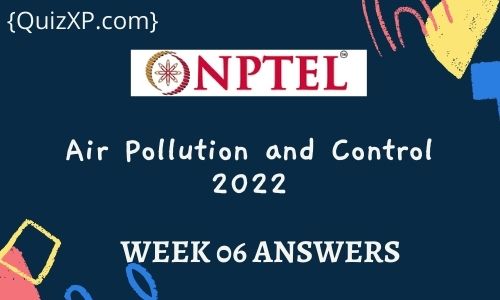Are you looking for the Answers to NPTEL Air Pollution and Control Assignment 6? This article will help you with the answer to the National Programme on Technology Enhanced Learning (NPTEL) Course “ NPTEL Air Pollution and Control Assignment 6 “
What is Air Pollution and Control?
The objective of the course is to impart the knowledge and understanding of causes and effects of air pollution and their controlling mechanisms. The course will provide a deeper understanding of air pollutants, pollution inventory and modelling. The course also imparts knowledge on the impacts of air pollution on different aspects such as policy, human health and various contemporary technological innovation for betterment of air quality.
CRITERIA TO GET A CERTIFICATE
Average assignment score = 25% of the average of best 8 assignments out of the total 12 assignments given in the course.
Exam score = 75% of the proctored certification exam score out of 100
Final score = Average assignment score + Exam score
YOU WILL BE ELIGIBLE FOR A CERTIFICATE ONLY IF THE AVERAGE ASSIGNMENT SCORE >=10/25 AND EXAM SCORE >= 30/75. If one of the 2 criteria is not met, you will not get the certificate even if the Final score >= 40/100.
Below you can find the answers for NPTEL Air Pollution and Control Assignment 6
| Assignment No. | Answers |
|---|---|
| Air Pollution Assignment 1 | Click Here |
| Air Pollution Assignment 2 | Click Here |
| Air Pollution Assignment 3 | Click Here |
| Air Pollution Assignment 4 | Click Here |
| Air Pollution Assignment 5 | Click Here |
| Air Pollution Assignment 6 | Click Here |
| Air Pollution Assignment 7 | Click Here |
| Air Pollution Assignment 8 | Click Here |
NPTEL Air Pollution and Control Assignment 6 Answers:-
Q1. What is the kerb site location?
a) Side of the water body
b) Side of the pavement
c) Outside the main city
d) Away from pavement
Answer: b) Side of the pavement
Q2. Which one of the following models is used in the bottom-up approach?
a) Positive mass factorization (PMF) model
b) Chemical mass balance (CMB) model
c) Lagrangian model
d) Principal Components Analysis
Answer: c) Lagrangian model
Q3. Top-down approach is also called
a) Receptor-based method
b) Source-based method
c) Emission inventory-based method
d) Dispersion based method
Answer: a) Receptor-based method
Q4. The fundamental principle of receptor modeling is
a) Mass conservation
b) Energy conservation
c) Normal distribution
d) Conservation of momentum
Answer: a) Mass conservation
???? Next Week Assignment Answers????
Q5. The main characteristics of receptor models is/are
a) Chemical mass balance principle
b) Based on the solution of multilinear equations
c) Do not depend on emission inventories
d) All the above
Answer: d) All the above
Q6. Match List-I with List-II and select the correct answer using the codes given below the lists: List I List II A. Organic carbon (OC) 1. High-performance liquid chromatography (HPLC) B. Inorganic elements 2. Thermal optical methods C. Organic compounds 3. Linear regression D. Analytical uncertainty 4. Inductively coupled plasma mass spectrometry (ICPMS)
a) A-2, B-1, C-4, D-3
b) A-2, B-4, C-1, D-3
c) A-1, B-3, C-2, D-4
d) A-1, B-3, C-4, D-2
Answer: b) A-2, B-4, C-1, D-3
Q7. Which of the following is not the cause of Indoor Air Pollution?
a) Poorly designed ventilation systems
b) Well-designed ventilation systems
c) Indoor sources of air pollution
d) Outdoor sources of air pollution
Answer: b) Well-designed ventilation systems
If there are any changes in answers will notify you on telegram so you can get a 100% score, So Join
Q8. Which of the following indoor air pollutants is responsible for irritation to the skin?
a) SO2
b) NOx
c) RSPM (Respirable Suspended Particulate Matter)
d) CO
Answer: b) NOx
Q9. What is the source of asbestos in the indoor environment?
a) Building maintenance
b) Glue
c) Insecticides
d) Fertilizers
Answer: a) Building maintenance
Q10. Which of the following are the biological indoor pollutants?
a) Mattresses
b) Pitchblende
c) Disinfectants
d) Uranium
Answer: a) Mattresses
For other courses answers:- Visit
For Internship and job updates:- Visit
Disclaimer: We do not claim 100% surety of answers, these answers are based on our sole knowledge, and by posting these answers we are just trying to help students, so we urge do your assignment on your own.
if you have any suggestions then comment below or contact us at [email protected]
If you found this article Interesting and helpful, don’t forget to share it with your friends to get this information.



